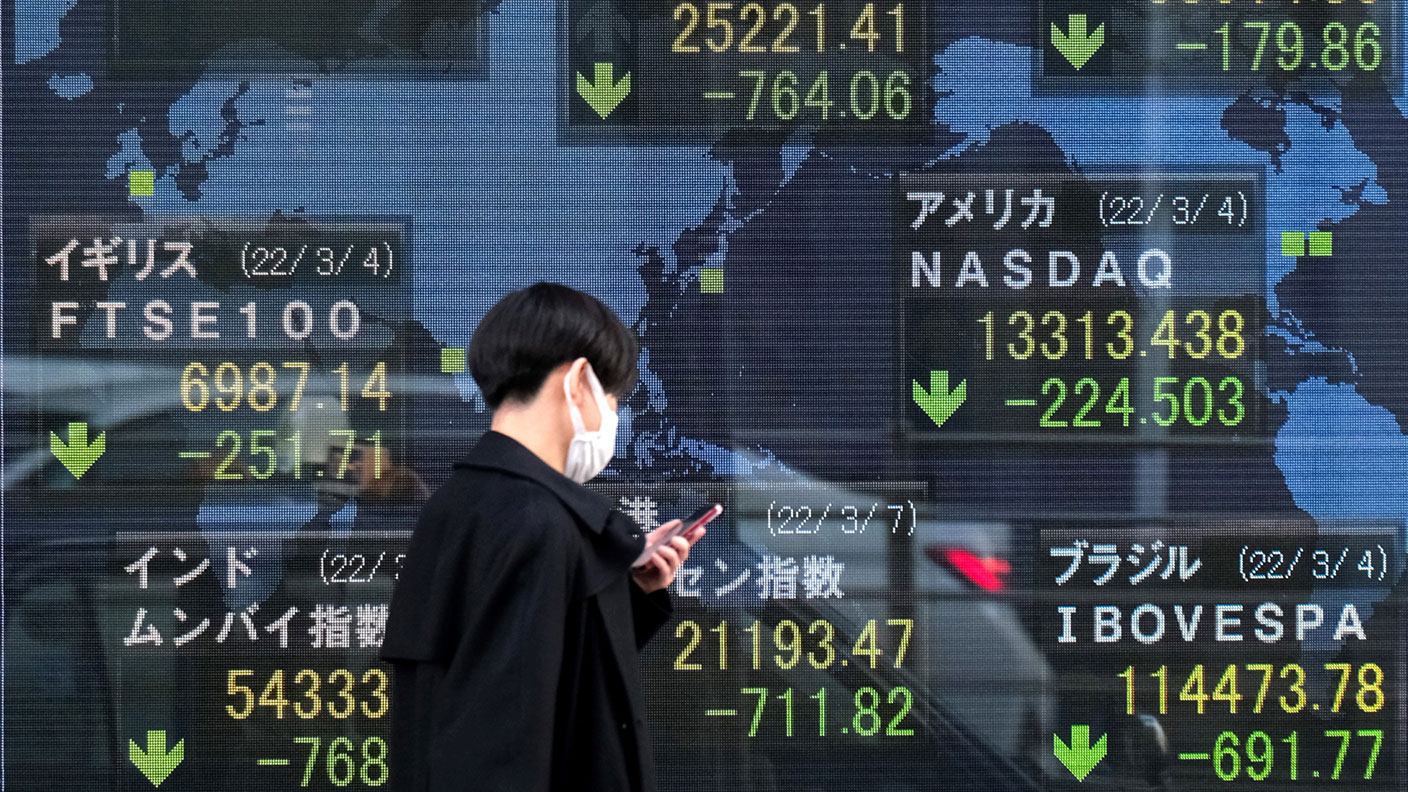Stockmarkets bounced strongly yesterday – have we been saved from a bear market?
Stockmarkets rose sharply yesterday after suffering big falls in recent weeks – but that doesn’t mean we've hit a bottom, says John Stepek. Here’s what’s going on.


Yesterday we saw a big bounce in stockmarkets, combined with a big plunge in commodity prices.
This was mostly pinned on vague but growing hope that a ceasefire deal might be reached in Ukraine (though it’s not clear to me whether there’s much to that or not).
Nevertheless, a bounce is a bounce, and a drop in oil prices would be welcome news for the economy.
Subscribe to MoneyWeek
Subscribe to MoneyWeek today and get your first six magazine issues absolutely FREE

Sign up to Money Morning
Don't miss the latest investment and personal finances news, market analysis, plus money-saving tips with our free twice-daily newsletter
Don't miss the latest investment and personal finances news, market analysis, plus money-saving tips with our free twice-daily newsletter
So what should we make of it?
Big rebounds follow big drops and vice versa
Yesterday’s surge in stockmarkets (and corresponding plunge in commodity markets) was disorientating.
The jump was mostly being put down to hopes that a ceasefire might be closer in Ukraine, but I suspect it’s more because markets were just itching to go up after a lot of falling (and commodities had reached a short-term parabolic moment).
So let’s take a step back and get some perspective. There are two key points to bear in mind.
The first thing to note about yesterday’s rally is that the biggest single-day movements in stockmarkets, whether up or down, tend to cluster.
The best ever days for the Dow Jones index (in percentage gain terms), for example, almost all happened between 1929 and the early 1930s. The other top ten comprises the post-Covid rebound in 2020; a couple of 2008 false rallies; and the post-1987 rebound.
Similarly, a list of the ten worst days clusters mostly around 1929, 1987, and 2020, with honourable mentions for a couple of much earlier panics, 1907 and 1889.
You’ll notice that these either come during very bearish periods – the Great Depression, the financial crisis, both arguably categorisable as depressions – or unusual but severe one-off events like 1987 and 2020.
So a big move higher is in itself, not generally indicative of a “bottom” as such. It’s more a sign that stocks have fallen a lot and that investors are panicky.
The second thing you’ll be hearing a lot about right now, which can muddy the water a bit, is how war and geopolitical events don’t matter. This will usually be accompanied by a chart which depicts how everything went up within a few months of the 1990s Gulf War, or the Cuban missile crisis, etc.
Some people will even cite Russia’s 2008 invasion of Georgia with a straight face, as if it was the most important thing happening in markets that year, rather than the epoch-defining, globe-spanning financial crisis that was already bubbling under the surface waiting to erupt.
These long lists don’t show anything more useful than to indicate that a) US markets (because it’s always US markets) are mostly oblivious to anything that happens outside of the US; and that b) US markets have mostly gone up over the last century.
The first point reminds us that just because the market went up a lot yesterday, doesn’t mean everything’s sorted now and it’s time to fill your boots. The second point reminds us that it’s true that individual geopolitical events really don’t matter to markets in the long run – instead, you have to consider the wider backdrop. So let’s turn to that now.
The war has made things worse, but it hasn’t changed the direction
This is where we need to give ourselves a bit of a shake and remember what was happening in the lead up to all of this.
Before yesterday’s rebound, the Nasdaq (among several other globally exposed markets) had entered bear market territory – it had fallen by more than 20% from its most recent high.
But I’d argue that the bear market in “jam tomorrow” stocks started back in February 2021; the Nasdaq was really just playing catch-up. A better measure is almost certainly to use Cathie Wood’s Ark Innovation ETF, which holds all of those sorts of stocks, and is down just over 60% since then.
Why did that bull market end? Because the main factors fuelling it ended. Inflation turned out not to be transitory. That put a halt to hopes for never-ending loose money. That’s the story in a nutshell.
Before Russia invaded Ukraine, all eyes today were going to be on the European Central Bank and its intentions to start tightening monetary policy, and then on the latest reading for US consumer price inflation, and what it might mean for monetary policy.
So assuming that the war in Ukraine stays local to Ukraine (because escalation beyond its borders would involve another set of recalculations, including existential risk), then the main impact on the market stems from what this war means for monetary policy.
And the answer to that is: it’s tricky.
Inflation looks set to go a lot higher
Investors have been used to central banks using big scary events (or even relatively small ones) to row back on their timetables for raising interest rates. Meanwhile, there is no doubt that as well as being scary, the war will squeeze living standards, because it has driven the prices of raw materials even higher, and those are translating into higher bills almost immediately.
However, that’s the tricky bit. Because the war is inflationary. No doubt about that. Inflation was already here. Now it’s going to be here for longer, and higher for longer.
I read a piece from Capital Economics the other day in which they revised their UK inflation forecast higher. They now reckon that UK consumer price inflation will peak at 8.3% in April (for perspective, on current spreads, that suggests retail price inflation, the old measure, would be into double-digits).
Perhaps more tellingly, they also think that inflation will still be 6.6% come December. That’s staggeringly high compared to anything we’ve seen for decades. The last time we saw a run of CPI being above 6% for over a year was from 1990 to 1991. (The peak in that period was 8.4%).
People often argue: but this isn’t the sort of inflation central banks can do anything about. But that’s not really true. What they mean is: it’s not the sort of inflation that central banks can do anything about without inflicting a huge amount of pain on the economy.
And at 8%, it’s pretty hard to ignore inflation and pretend it’s going to go away when it clearly isn’t.
I’m not saying that central banks should or shouldn’t raise interest rates. Mainly, I don’t think they should’ve kept monetary policy as loose as they have over the past few decades, and our problems now would be far less significant. Instead we’re left facing largely bad choices.
From your point of view it means: manage your personal finances actively again. Look at things you might once have felt broadly happy to ignore – like your bills, your savings rates – more regularly and switch where you can find savings.
Also, if you have the wherewithal, make sure you’re using your allowances on pensions and Isas where you can, because taxes are likely to go up in the longer run too. We’re just finishing putting together our annual Isa supplement for MoneyWeek magazine, so make sure you get your first six issues free by subscribing here.
Get the latest financial news, insights and expert analysis from our award-winning MoneyWeek team, to help you understand what really matters when it comes to your finances.
John Stepek is a senior reporter at Bloomberg News and a former editor of MoneyWeek magazine. He graduated from Strathclyde University with a degree in psychology in 1996 and has always been fascinated by the gap between the way the market works in theory and the way it works in practice, and by how our deep-rooted instincts work against our best interests as investors.
He started out in journalism by writing articles about the specific business challenges facing family firms. In 2003, he took a job on the finance desk of Teletext, where he spent two years covering the markets and breaking financial news.
His work has been published in Families in Business, Shares magazine, Spear's Magazine, The Sunday Times, and The Spectator among others. He has also appeared as an expert commentator on BBC Radio 4's Today programme, BBC Radio Scotland, Newsnight, Daily Politics and Bloomberg. His first book, on contrarian investing, The Sceptical Investor, was released in March 2019. You can follow John on Twitter at @john_stepek.
-
 How does the Lifetime ISA work? Key LISA rules
How does the Lifetime ISA work? Key LISA rulesWhat is a Lifetime ISA (LISA) and how much could the government bonus boost your savings by? We look at the perks and the pitfalls.
-
 AJ Bell: a fine British fintech going cheap
AJ Bell: a fine British fintech going cheapOpinion Don’t overlook investment platform AJ Bell, a significantly undervalued British business with an excellent financial base
-
 Halifax: House price slump continues as prices slide for the sixth consecutive month
Halifax: House price slump continues as prices slide for the sixth consecutive monthUK house prices fell again in September as buyers returned, but the slowdown was not as fast as anticipated, latest Halifax data shows. Where are house prices falling the most?
-
 Rents hit a record high - but is the opportunity for buy-to-let investors still strong?
Rents hit a record high - but is the opportunity for buy-to-let investors still strong?UK rent prices have hit a record high with the average hitting over £1,200 a month says Rightmove. Are there still opportunities in buy-to-let?
-
 Pension savers turn to gold investments
Pension savers turn to gold investmentsInvestors are racing to buy gold to protect their pensions from a stock market correction and high inflation, experts say
-
 Where to find the best returns from student accommodation
Where to find the best returns from student accommodationStudent accommodation can be a lucrative investment if you know where to look.
-
 The world’s best bargain stocks
The world’s best bargain stocksSearching for bargain stocks with Alec Cutler of the Orbis Global Balanced Fund, who tells Andrew Van Sickle which sectors are being overlooked.
-
 Revealed: the cheapest cities to own a home in Britain
Revealed: the cheapest cities to own a home in BritainNew research reveals the cheapest cities to own a home, taking account of mortgage payments, utility bills and council tax
-
 UK recession: How to protect your portfolio
UK recession: How to protect your portfolioAs the UK recession is confirmed, we look at ways to protect your wealth.
-
 Buy-to-let returns fall 59% amid higher mortgage rates
Buy-to-let returns fall 59% amid higher mortgage ratesBuy-to-let returns are slumping as the cost of borrowing spirals.
